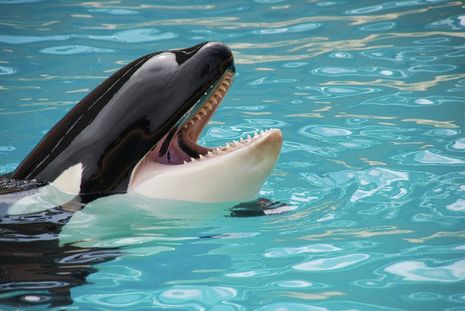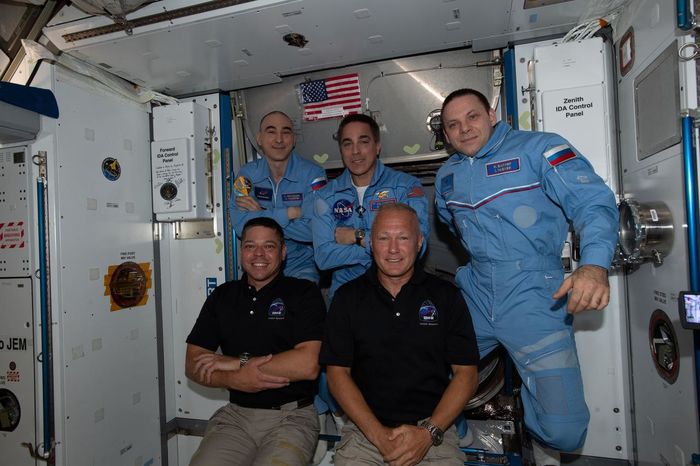Intelligent Others: Is bigger always better?
Shivani Sekar discusses the socially attuned and incredibly talkative bearers of some of the largest brains on the planet: whales and dolphins.

It’s difficult to believe that humans are the only intelligent lifeform in the universe. Despite this seemingly self-aware idea, the search for intelligent life has turned to other planets, inherently crowning humans as the most intellectually superior creatures on Earth. It is only relatively recently that we have turned our attention to the biggest brains of the planet, beneath the sea.
The biggest brains on the planet
Sperm whales (Physeter macrocephalus) and killer whales (Orcinus orca) have the largest known brain masses of any living animal. A mature male sperm whale can have a brain that weighs up to 9kg, and killer whale brains can reach 6kg. In contrast, the average human brain is only 1.4kg. However, the complex architecture of the brain means that comparisons of absolute mass are unhelpful when assessing cognitive abilities. Encephalisation Quotient or ‘EQ’ is the ratio between the actual brain mass, and the predicted brain mass for an animal of that size (and is also more accurate than a simple brain to body mass ratio). Humans have the highest known EQ at 7.5, with cetaceans such as the bottlenose dolphin coming second at 4.1-4.5, and sperm whales lagging behind at 0.58. There are plenty of criticisms levelled at EQ-based assessments of ability, and whilst the sperm whale brain’s size may not be as impressive as we originally thought, there is still strong evidence that we should not underestimate them.
Spindle, or ‘von Economo’, neurons are large neurons that have almost exclusively been identified in certain intelligent K-selected (essentially, K-selection is ‘quality over quantity’, as opposed to r-selection) species such as apes, elephants and cetaceans. These neurons have been associated with higher level abilities, including problem-solving and reasoning, and are thought to be three times as abundant in cetacean brains as in humans. There has also been speculation that these neurons are an example of convergent evolution, as distantly-related groups such as humans and cetaceans have independently developed them. Despite this, cetacean brains have a lower density of neurons than humans, with a higher glial cell to neuron ratio. Whilst this may seem like another obvious reason to ignore brain size, some studies have shown that they probably have greater neuronal connectivity, which still supports higher processing.
Think deeply, feel deeply
Our limited understanding of the human brain and what factors contribute to intelligence is so nebulous that we can hardly draw justified conclusions. What we can observe quite clearly in cetaceans, is the ability to form complex fission-fusion social groups, resembling human societies in a way that is unmatched by other species. These dynamic social groups include the formation of allies for ‘warfare’, and even hierarchies for mating. Alloparental care is also observed, as female sperm whales babysit calves at the water surface, whilst deep-diving mothers forage for food. In fact, many of their hunting strategies require the group to collaborate and use their ingenuity. Orcas work together to create air bubbles and flash their white undersides in order to herd schools of herring into dense balls in ‘carousel feeding’. They then slap the ball with their powerful flukes, stunning the fish before feasting on them. Orcas can also turn formidable sharks into prey by ‘karate chopping’ their heads, making them the true apex predators of the sea.
From ‘Moby Dick’ to ‘Blackfish’, cetaceans are shown to be capable of great empathy and even mental illness. An injured sperm whale in the wild is protected fiercely by its pod, in a defensive ‘marguerite formation’, encircling the member with their flukes outward. Cetaceans show interspecies altruism, as one of the few animals that has consistently been shown to aid humans (although this is also controversial). Killer whales have close-knit matrilines, with pods having distinct calls and names for each other. Various tagged orcas have shown prolonged mourning periods for deceased young, carrying dead calves for up to a week. This emotional intelligence also raises important questions about the ethics of keeping these animals in captivity.
Cognitive abilities
Human infants first develop the ability to recognise themselves in a mirror (mirror self-recognition) at 12 months, and chimpanzees at 2 years old at the earliest. Early self-awareness is rare, and only observed in a few primates. In contrast, dolphins have been shown to recognise their own bodies in a mirror test from 6-7 months, and when a mark is painted onto their heads, subjects also pay additional attention to the new mark. This suggests that cetaceans can produce a sense of ‘I’ – indicating higher-level thinking. These dolphins can also communicate with humans, by understanding gestures, and responding. What is even more impressive, is that they are aware that the human they are trying to communicate with must be present and watching them before they perform the gesture, suggesting an ability to imagine a ‘non-self’ person’s point of view.
Whales also teach successful hunting tactics to their young. Certain killer whales are thought to intentionally strand themselves to lunge at seals on the shore, before returning to deeper waters. Juveniles are pushed towards the shore by older members of the group to teach them this skill. Others hunt for fish using tools such as sea-sponges to protect their noses from the seabed, and also teach others to do this. However, primates are still considerably more adept at using tools.
Despite the wealth of information suggesting that cetaceans are capable of complex emotion and abstract thinking, we are reluctant to consider this at depth. This is despite our understanding of the paradox that we cannot accurately test their intelligence without knowing how they think, or their motivations. One study showed that when a sample group of humans were made conscious of their own mortality, and then information was provided suggesting that cetaceans are smarter, the sample group had negative responses, disliking the information and the animal. Terror Management Theory (TMT) uses this to suggest that it is in our nature to fear that we are not the most intelligent beings on the planet, as it makes us aware of our own vulnerability, and how inconsequential we may be. This is perhaps what has hindered our ability to think objectively about cetacean intelligence.
 News / Caius mourns its tree-mendous loss23 December 2025
News / Caius mourns its tree-mendous loss23 December 2025 Comment / Yes, I’m brown – but I have more important things to say22 December 2025
Comment / Yes, I’m brown – but I have more important things to say22 December 2025 News / Clare Hall spent over £500k opposing busway 24 December 2025
News / Clare Hall spent over £500k opposing busway 24 December 2025 Interviews / Politics, your own way: Tilly Middlehurst on speaking out21 December 2025
Interviews / Politics, your own way: Tilly Middlehurst on speaking out21 December 2025 News / King appoints Peterhouse chaplain to Westminster Abbey22 December 2025
News / King appoints Peterhouse chaplain to Westminster Abbey22 December 2025









